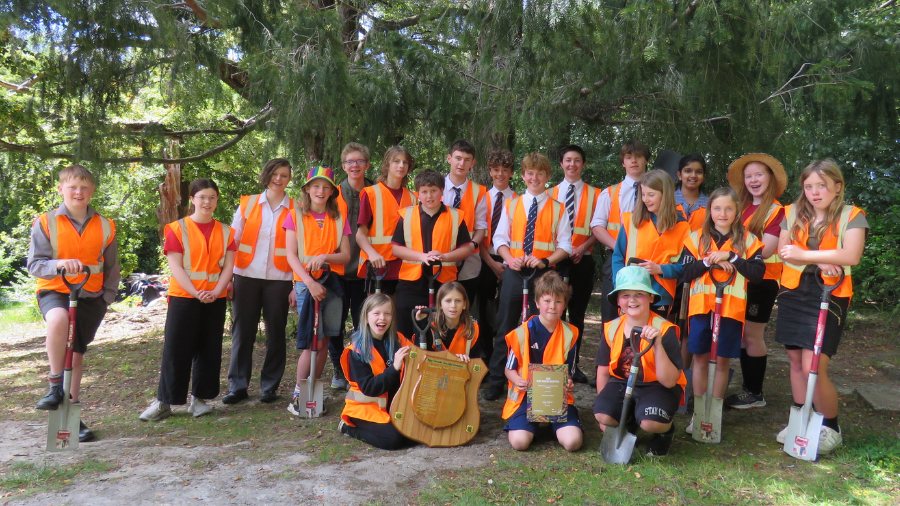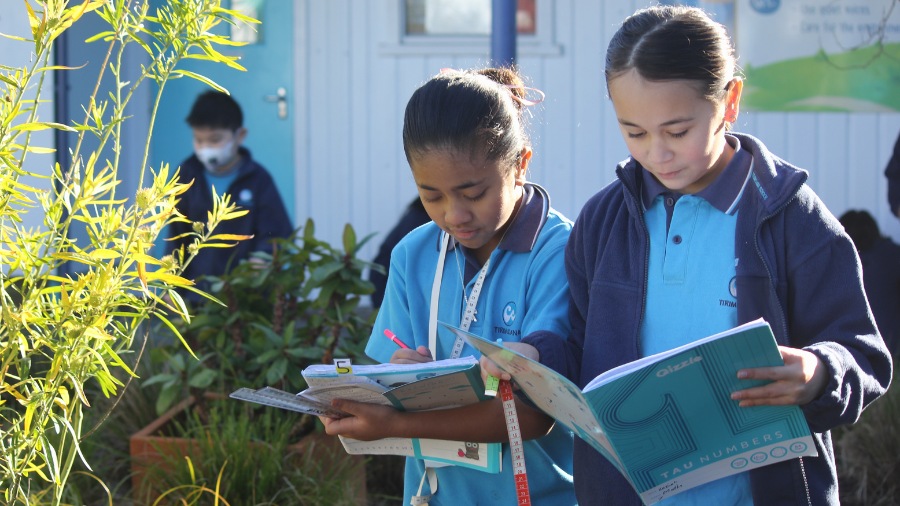Our Stories of Nature
Children's books are rich with meaning and inspiration, providing opportunities for young people to connect with places and living things that they love. Engaging illustrations and thoughtfully crafted stories can build empathy, curiosity and a strong connection with nature in Aotearoa.
In June 2024 we hosted two online panel discussions with Aotearoa authors and illustrators, exploring the potential for children's books to strengthen literacy learning alongside place-based and environmental education.
“Storytelling is empathic by nature because it’s about human connections. Adding nature into the story encourages that empathic connection with nature as well.”
- Isobel Joy Te Aho-White
Facilitated by Linda Jane Keegan, children's author and editor of The Sapling, these recorded webinars are no are longer available to view, but this Spotlight includes some highlights from the discussions, ideas for teaching and learning and a collection of books to use with ākonga of all ages.
Storytelling, Empathy and Te Ao Māori
Our first webinar explored the importance of storytelling, including the use of illustrations and oral storytelling, to build empathy and a sense of connection for young people. The guests were Gavin Bishop, Isobel Joy Te Aho-White and Kate Parker.
“I think the marvellous thing about oral storytelling is the communication you can have with your audience. Often I will tell the book in my own words, instead of reading it. I love doing that - you can look at your audience, instead of just the pages of the book.” - Gavin Bishop
Gavin's award-winning books, including Wildlife of Aotearoa, Atua - Māori Gods and Heroes, and Aotearoa -The New Zealand Story, are a masterclass in storytelling, with his combination of carefully considered hand-drawn illustrations alongside text that is rich with mātauranga Māori and respect for the environment.
Kate Parker's book Kōwhai and the Giants is illustrated using photographs of her intricate paper cut artwork, placed within light boxes and originally displayed as an exhibition. She focuses on sharing the wonder of nature, as a way to bring attention to environmental issues without getting drawn into feelings of hopelessness.
“I keep going back to things that are magic - I love learning about nature and Aotearoa creatures. There’s a magic in what they do and I love discovering what that is and how that might feel or what it might feel like to be inside that character or creature, or land or tree.” - Kate Parker

Isobel Joy Te Aho-White is an illustrator of Kāi Tahu, Ngāti Kahungunu and Pākehā descent. She has published thirty picture books, including Whiti: Colossal Squid of the Deep and Matariki Around the World, as well as work in School Journals.
Isobel's versatility as an illustrator stems from a technical training and appetite for experimentation, and at the core of much of her work is her love for te taiao and mātauranga Māori.
“Te Reo Māori is a very nature-based language. Kids are learning about maramataka, Matariki and their pepeha and these are very grounded in nature.” - Isobel Joy Te Aho-White
Nurturing Curiosity and Creativity
Our second webinar included a focus on getting young people outside in nature, with discussions about the joy of noticing the small things and feeling connected with te taiao. The guest speakers were Giselle Clarkson, Rachel Clare, Valetta Sówka and Rachel Haydon.
Valetta's book Family of Forest and Fungi: He Tukutuku Toiora was a vehicle to help explore her Māori and Pākehā roots, using fungi as a metaphor for interconnections, since te ao Māori is based on everything being interconnected.
“When you start out with your basic outlook, with such a strong connection to Papatūānuku and the land, you can’t help but be respectful of Mother Nature, and I could just see the difference between my Pākehā upbringing and te ao Māori.”
- Valetta Sówka
For Valetta it was also important to include tactile and sensory activities, such as listening, smelling and touching, to help connect the reader with their environment and also see their role within it.
Rachel Haydon is the National Manager of the National Aquarium of New Zealand in Ahuriri, as well as a qualified primary school teacher and scientist. She is dedicated to motivating children of all ages to get outside and explore, connect with nature and have the best chance to protect the natural world and all that lives within it.
Rachel's books, The Nature Activity Book and The Beach Activity Book are designed to be written and drawn in, acting as a prompt to explore further. The activities are informed by research about the Pathways to Nature Connection, along with mātauranga Māori.
“We need to think more broadly about learning - often creativity or fun are not seen as valid learning experiences. I just love the inspiration, motivation and questions that come from experiencing animals up close.” - Rachel Haydon

Rachel Clare has a background in children's book publishing and garden journalism and was also involved with the Garden To Table education programme.
Her book Play Wild: Nature Craft Projects for Tamariki is an invitation to get outside, make stuff and get dirty. She thought carefully about including a range of activities that would appeal to different children, including water play, art and gardening.
Rachel also made sure that all the materials needed for the activities could easily be found around the garden, using natural items as much as possible.
"Programmes like Garden to Table, or growing your own kai, aren't just about learning where our food comes from, but also discovering the joy of growing and how beneficial being outside is for our wellbeing. If we develop the habit of spending time in nature from a young age, hopefully as adults we'll intuitively know that time in nature makes us feel good.” - Rachel Clare
Giselle Clarkson is an award-winning author and illustrator, well known for her quirky and hilarious cartoons, including regular contributions to School Journals and the New Zealand Geographic magazine.

She wrote The Observologist: A Handbook for Mounting Very Small Scientific Expeditions to encourage people to look closely and be extra curious about their surroundings.
“The more you know about a creature, the more fascinating it is because there are more and more questions to ask yourself. The Observologist is about equipping the reader with some of those starting facts and how to notice things safely, including suggestions for tools to use, like a mirror to look at the underside of fungi.” - Giselle Clarkson
All of our guests agreed that time playing and exploring outside and children's books that reinforce our connection with nature are an important part of learning and childhood.
“When you start immersing yourself in nature and see how everything has a role, then a child starts to understand that and can reflect that on themselves. Understanding that they serve a purpose and they’re special in their own way. Acceptance of yourself can help with more natural and authentic expression in writing.” - Valetta Sówka
“Time spent outside enriches our imaginations, which then translates into capturing those ideas as writing or drawing. Books about nature can also inspire us to think about how we want nature to be.” - Rachel Clare
Teaching and Learning Ideas
Children's natural love and curiosity for te taiao can be nurtured and strengthened using books and storytelling. Our webinar guests and participants provided lots of ideas for how you could incorporate books into your learning programmes and spend more time outside.
- Create daily storytelling rituals, such as reading aloud to the whole class at the start or end of the day.
- Have a kete of books available while ākonga are playing outside, for when they need a quiet moment or want to find an answer to a question.
- Role model curiosity by exploring outside with ākonga and expressing joy when reading stories that reflect your local places or personal identity.
- Focus on the senses and allow lots of time for free play in nature - these will both encourage creativity and imagination.
- Encourage older tamariki to write reviews of their favourite books, like these Kiwi Conservation Club members, or write and illustrate their own stories about their favourite places and friends in nature.
- Secondary teachers can find suggestions for texts and learning in our Spotlight article English Curriculum for Te Taiao, written by Nicola Easthope.
“When I go outside, I find words come to me and I want to describe what I’m hearing or smelling and it lends itself to writing. I’ve taken kids outside to sit down quietly, close their eyes and then count how many things they can hear. They can capture what they’re experiencing and then put it into words, either verbally or on paper.” - Linda Jane Keegan
Book Collections
We've gathered nature-themed books for tamariki aged 3 - 12 years old, grouped into categories so you can choose something relevant for you and your ākonga. You'll find a mixture of fiction, creative non-fiction and activity books, and all of them include wonderful illustrations and messages of respect and connection with nature.
Download the Book List here, ordered by learning contexts / themes, with suggested age ranges and links to teaching notes.
Below is a smaller selection of books - click on the bold titles to find out more about each book in the lists below.
Books for Early Learners

Whose Home is This? by Gillian Candler, illustrated by Fraser Williamson
Song of the River by Joy Cowley, illustrated by Kimberley Andrews
We're Off to Find a Kiwi by Juliette MacIver, illustrated by Kate Wilkinson
To Catch a Cloud by Elena de Roo and Hannah Peck
I am Jellyfish by Ruth Paul
Nanny Mihi and the Rainbow by Melanie Drewery, illustrated by Tracy Duncan
Older Children (Ages 8+)

Kōwhai and the Giants by Kate Parker
The Observologist by Giselle Clarkson
Ultrawild by Steve Mushin
Tree Beings by Raymond Huber, illustrated by Sandra Severgnini
Wildlife of Aotearoa and Atua by Gavin Bishop.
Stranded by Linda Jane Keegan, illustrated by Isobel Joy Te Aho-White
Te Reo Māori and Bilingual

Family of Forest and Fungi - He Tukutuku Toiora by Valetta Sowka, te reo Māori translations by Hana Park, illlustrated by Isobel Te Aho-White.
Whakarongo ki ō Tūpuna - Listen to your Ancestors by Darryn Joseph, illlustrated by Munro Te Whata
I Waho, o te Moana translated by Pānia Papa, from Out in the Moana by Yvonne Morrison, illustrated by Jenny Cooper.
Te Taiao by Sharon Holt, photography by Rachel Hale McKenna
Activity Books

The Nature Activity Book and the Beach Activity Book by Rachel Haydon, illustrated by Pippa Keel
Play Wild by Rachel Clare
New Zealand Nature Heroes by Gillian Candler
Includes inspiring stories of conservation heroes from past and present, alongside practical activity ideas.
Sylvia and the Birds by Johanna Emeney and Sarah Laing. This book is a mixture of graphic biography, practical guide and activity book, with mātauranga Māori insights.
Welcome to NZ: A Nature Journal by Sandra Morris
If you're looking for identification books for Aotearoa plants and animals, we recommend reading this wonderful summary from The Sapling, written by Linda Jane Keegan: Which New Zealand Nature Guide?
Happy reading and let us know if we've missed your favourite book from our list!
“I love the idea of adults also having that joy of discovering things and that your curiosity will rub off onto children. Let’s figure it out together.” - Linda Jane Keegan






